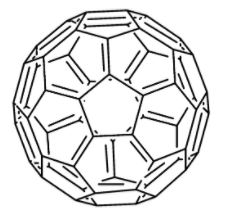
Write short note on buckyball
Answer
489.6k+ views
1 likes
Hint: Buckyballs are also known as fullerenes or buckminsterfullerene. Buckyballs were one of the first nanoparticles invented. These nanoparticles were discovered in 1985 by a group of three researchers namely Richard Smalley, Harry Kroto, and Robert Curl, working at Rice University.
Complete step by step answer:
Buckyballs are carbon atoms connected to three other carbon atoms via covalent bonds. However, the carbon atoms are connected to each other in the pattern similar to hexagons and pentagons (cage-like fused-ring structure) as visible on a soccer ball, thus, giving a buckyball the spherical structure. The most general form of buckyball comprises 60 carbon atoms and is therefore called as

Buckyball is a black solid having the ability to dissolve in hydrocarbon solvents to generate a violet solution. The molecule is usually present in small quantities in soot. The molecule has also been found in deep space. Moreover, in April 2019, scientists carrying out research with the Hubble Space Telescope, have reported the confirmed occurrence of the huge and complex ionized molecules of buckyballs (
Note: The covalent bonds between carbon atoms make the buckyballs very strong, and the carbon atoms easily form covalent bonds with other atoms. Buckyballs are also utilized in composites to strengthen the material. Moreover, buckyballs possess the electrical property of being very good electron acceptors, thereby indicating that they accept loose electrons from other materials. This property is useful in increasing the efficacy of solar cells in transforming sunlight into electricity.
Complete step by step answer:
Buckyballs are carbon atoms connected to three other carbon atoms via covalent bonds. However, the carbon atoms are connected to each other in the pattern similar to hexagons and pentagons (cage-like fused-ring structure) as visible on a soccer ball, thus, giving a buckyball the spherical structure. The most general form of buckyball comprises 60 carbon atoms and is therefore called as

Buckyball is a black solid having the ability to dissolve in hydrocarbon solvents to generate a violet solution. The molecule is usually present in small quantities in soot. The molecule has also been found in deep space. Moreover, in April 2019, scientists carrying out research with the Hubble Space Telescope, have reported the confirmed occurrence of the huge and complex ionized molecules of buckyballs (
Note: The covalent bonds between carbon atoms make the buckyballs very strong, and the carbon atoms easily form covalent bonds with other atoms. Buckyballs are also utilized in composites to strengthen the material. Moreover, buckyballs possess the electrical property of being very good electron acceptors, thereby indicating that they accept loose electrons from other materials. This property is useful in increasing the efficacy of solar cells in transforming sunlight into electricity.
Recently Updated Pages
Master Class 12 Economics: Engaging Questions & Answers for Success

Master Class 12 Maths: Engaging Questions & Answers for Success

Master Class 12 Biology: Engaging Questions & Answers for Success

Master Class 12 Physics: Engaging Questions & Answers for Success

Master Class 12 Business Studies: Engaging Questions & Answers for Success

Master Class 12 English: Engaging Questions & Answers for Success

Trending doubts
Which one is a true fish A Jellyfish B Starfish C Dogfish class 10 biology CBSE

The Equation xxx + 2 is Satisfied when x is Equal to Class 10 Maths

Why is there a time difference of about 5 hours between class 10 social science CBSE

Fill the blanks with proper collective nouns 1 A of class 10 english CBSE

When and how did Canada eventually gain its independence class 10 social science CBSE

What is the median of the first 10 natural numbers class 10 maths CBSE




